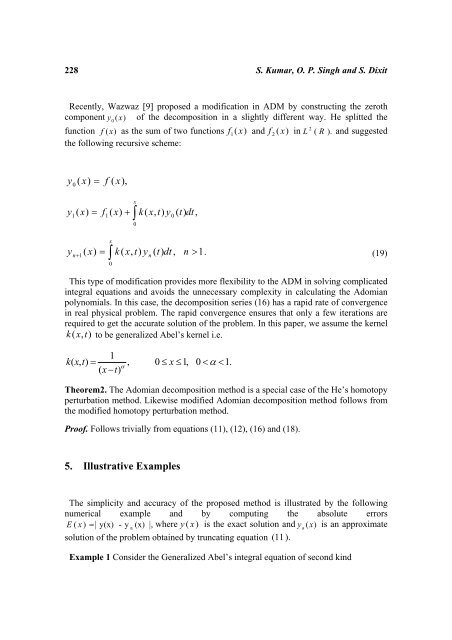An Analytic Algorithm for Generalized Abel Integral Equation
An Analytic Algorithm for Generalized Abel Integral Equation
An Analytic Algorithm for Generalized Abel Integral Equation
You also want an ePaper? Increase the reach of your titles
YUMPU automatically turns print PDFs into web optimized ePapers that Google loves.
228 S. Kumar, O. P. Singh and S. Dixit<br />
Recently, Wazwaz [9] proposed a modification in ADM by constructing the zeroth<br />
component 0 ( ) x y of the decomposition in a slightly different way. He splitted the<br />
function f (x)<br />
as the sum of two functions 1( ) x f and ) (<br />
2 f 2 x in L ( R ). and suggested<br />
the following recursive scheme:<br />
y ( x)<br />
=<br />
0<br />
1<br />
f ( x),<br />
y ( x)<br />
= f ( x)<br />
+<br />
y<br />
n+<br />
1<br />
1<br />
x<br />
x<br />
∫<br />
( x)<br />
= ∫ k ( x,<br />
t)<br />
y<br />
0<br />
0<br />
k ( x,<br />
t)<br />
y<br />
n<br />
0<br />
( t)<br />
dt ,<br />
( t)<br />
dt,<br />
n > 1.<br />
This type of modification provides more flexibility to the ADM in solving complicated<br />
integral equations and avoids the unnecessary complexity in calculating the Adomian<br />
polynomials. In this case, the decomposition series (16) has a rapid rate of convergence<br />
in real physical problem. The rapid convergence ensures that only a few iterations are<br />
required to get the accurate solution of the problem. In this paper, we assume the kernel<br />
k ( x,<br />
t)<br />
to be generalized <strong>Abel</strong>’s kernel i.e.<br />
1<br />
k(<br />
x,<br />
t)<br />
= , 0 ≤ x ≤1,<br />
0 < α < 1.<br />
α<br />
( x −t)<br />
Theorem2. The Adomian decomposition method is a special case of the He’s homotopy<br />
perturbation method. Likewise modified Adomian decomposition method follows from<br />
the modified homotopy perturbation method.<br />
Proof. Follows trivially from equations (11), (12), (16) and (18).<br />
5. Illustrative Examples<br />
The simplicity and accuracy of the proposed method is illustrated by the following<br />
numerical example and by computing the absolute errors<br />
E ( x ) = | y(x) - y a (x) |, where y ( x ) is the exact solution and ya (x)<br />
is an approximate<br />
solution of the problem obtained by truncating equation ( 11).<br />
Example 1 Consider the <strong>Generalized</strong> <strong>Abel</strong>’s integral equation of second kind<br />
(19)

















